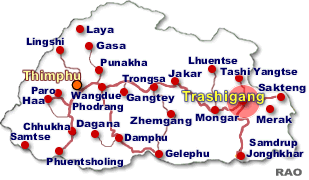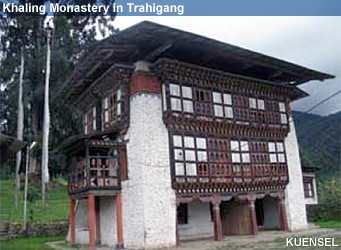|
Goenpas,
Monasteries & Lhakhangs
|
 |
Bhutan'sMonasteries |
|
 |
Bhutan Information |
|
|
 |
|
Trashigang:
Khaling Goenpa
|
 |
 |
|
The 400-year old Khaling gonpa is the biggest structure in Khaling valley. To the villagers of Dawzor, Rashong and Gonpa the three-storied lhakhang is an indispensable part of their lives; they hold all their religious rites there.
But appointing a caretaker has become a problem. Of the 16 households in Gonpa village where the lhakhang is situated, there are only six villagers who are capable of shouldering the responsibility of a caretaker.
|
|
Five houses are empty and locked, the owners have either moved away or work in other dzongkhags. The other five have only old people.
"Whether we like it or not, we have to take turns taking care of the lhakhang," said the present caretaker, Jigme, 59. With stories of lhakhang robberies and chorten vandalism rife, Jigme said taking care of lhakhang is a risky job. "If anything goes missing I will be charged, I could even lose my life to people who come to rob lhakhangs," he said.
The four chortens in the vicinity of the lhakhang was vandalised and their relics stolen. One chorten near the lhakhang had been dug out only a few months ago. A rhino horn was stolen from the Jadrung lhakhang under Khaling gewog and the caretakers were imprisoned for a year about a decade ago.
Like many caretakers across the country, Jigme is paid in kind, about nine kilogrammes of maize annually from the villagers, which is worth about Nu 2,000 to Nu 3,000. "The contribution is nothing given the risk," said Jigme.
|
But it is not the risk alone that lhakhangs are running short of caretakers, according to villagers.
The other reasons many gups agree were the abolishment of the zhabtog lemi (customary work contributions) in maintaining roads, bridges and dzongs.
A gup said that that a villager who volunteered to become the caretaker was exempted from contributing lanour. "When the labour contribution was abolished, there were no people wanting to become koenyers," said Yangneer gup, Duptho.
|
|
 |
The problem is widespread in the dzongkhag.
A lhakhang in Dakpadung in Shongphu gewog had been under lock and key about four months, according to the village tshogpa. "None of the gomchens want be the caretaker, so the public had to take turns," he said. "There are no people in the villages to work as koenyer (caretaker)," said a Yangneer village elder. "Everybody is living or moving out of the villages looking for better life."
Gups in Trashigang said that it is the most common problem in many of the villages in the dzongkhag where communities own lhakhangs. The Yangneer gup, Duptho, said that unlike in the past, lay monks are not keen on becoming caretakers as they can earn easy money outside the temples. "Today gomchens drop out of gomdeys and go to urban centres to become drivers or work as daily wage earners," he said.
Local leaders said that number of gomchens staying in the villages is decreasing every year. "While the old retire, there are not many wanting to become gomchens because there is a school in every gewog," said Dorji Penjor, a former gomchen who served more than nine times as a koenyer. The gup added that the trend of sending the young to gomdeys had changed as more and more villagers realized the value of modern education.
Local leaders in Trashigang said that people, including gomchens, are leaving for the urban centres in search of jobs. While some are already working in the government or private sector, young villagers are leaving in search of other opportunties. "The fields are getting fallow and more houses are getting locked," said a village mangmi.
Khaling gup, Kinzang Tobgay said that it's become increasingly difficult to appoint new caretakers because people think the temples are not safe anymore and that the contributions are not much.
The issue was discussed in the dzongkhag tshogdu last month. The gewog representatives submitted that some incentives or remuneration be given to the caretakers.
The issue was earlier discussed in the 87th session of the national assembly. The people submitted that either the dratshang provide caretakers or the communities would surrender the temples to the dratshangs or choedeys. Trashigang DYT chairman Ugyen Dorji said that their decision was also based on the resolution of the national assembly that provisions of incentives was not feasible.
"It is the responsibility of every individual in the community to take care of the lhakhangs and the community leaders should explain this to the people so that they come forward to take care of their lhakhangs," Trashigang dzongda Lungten Norbu said during the session.
 |
| Contributed
by Tshering Palden , Kuensel 2010 |
| Information on Bhutan |
 |
|




